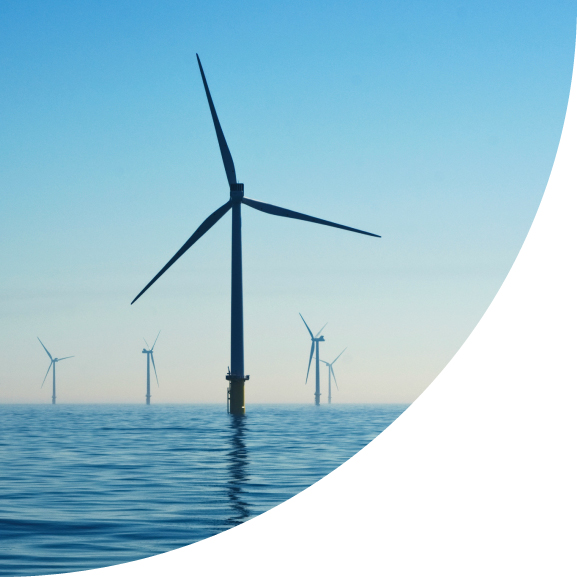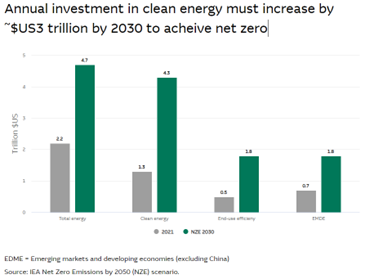Monthly Investment Note - Energy Transition

Monthly Investment Note - Energy Transition
This month, we take a look at the Energy Transition thematic. We focus on the key themes shaping the transition to a more sustainable future, the threats, and opportunities and how to position portfolios for a potentially cleaner world.
The term 'energy transition' refers to the global shift from traditional, fossil-fuel-based energy sources to cleaner, more sustainable, and renewable energy sources. This transition is driven by several key factors, including environmental concerns, energy security, and economic considerations.
The World Energy Transitions Outlook outlines a pathway for the world to achieve the Paris Agreement goals and hopefully significantly reduce the pace of climate change by transforming the global energy landscape to ultimately bring CO2 emissions to net zero by 2050.
The International Renewable Energy Agency (IRENA) analysis shows that over 90% of the solutions shaping a successful outcome in 2050 involve renewable energy through direct supply, electrification, energy efficiency, green hydrogen and bioenergy combined with carbon capture and storage (BECCS). Innovative solutions are reshaping the energy system.

Over the years organisations such as IRENA, International Energy Association (IEA) and the UN (formation of the 17 Sustainable Development Goals, SDGs, the annual COP Conference), along with numerous other related parties, have been working towards the common goal of solving the worlds energy problems. This has not been an easy exercise with numerous challenges faced throughout this period notwithstanding the fact that world's leading energy source has changed only twice since the 1800s: from wood to coal in 1900 and coal to oil in 1960’s.
What these organisations are trying to achieve and facilitate is now being referred to as the “energy trilemma”; a term coined by the World Energy Council; The need to deliver energy that is sustainable, secure and affordable.
Several key themes have emerged over the years pitting the new economy vs the old economy. These are becoming more widely accepted as the way forward.
- The energy transition comes at a price,
- Technology solutions will have a big part to play,
- Demand for fossil fuels will continue to rise in the medium-term,
- Policy is the key driver,
- Transmission and infrastructure networks must be reliable & efficient,
- Lack of transition metals.
These themes carry along with it, threats and opportunities which is not unusual during major global transition. Some examples include:
Threats
- Economic Disruptions
- Stranded Assets
- Energy Access and Affordability (part of the Trilemma)
- Investment and uptake of renewables by energy companies and electric utilities
Opportunities
- Innovation and technological advancements
- Job Creation and Economic Growth
- Environmental Benefits (and Climate Action) – the obvious opportunity and outcome

Getting exposure to the transition
Themes come and go however the ‘energy transition’ is one that will play out over decades resulting in plenty of opportunity for investors. As noted above, the massive level of investment needed and the subsequent evolution required by a number of sectors/industries, both new and existing, will provide these opportunities.
Solar, offshore wind, and hydrogen perhaps are seen as the obvious choices however opportunities will become available across the whole value chain within transport and infrastructure, carbon capture,utilisation & storage (CCUS), renewable energy, grid modernisation, and plenty of export opportunities, especially for Australia.
Although the transition is not all about decarbonisation, most of the investment needed to decarbonise the economy is in sectors that are currently high carbon. So, investing in the transition also means investing in carbon-intensive companies that have credible transition plans and/or that supply the materials, equipment and services needed for the transition.
At the end of the day however, policy will likely dictate the flow of capital.
Conclusion
The success of the energy transition depends on transformation of the global energy sector from fossil-based to zero-carbon sources by the second half of this century is one that will be difficult to achieve. It will require immense investment both monetary and intellectual, as well as the willingness of countries worldwide to ensure consistency in targets and actions.
The opportunities, challenges, and risks associated with a more orderly energy transition are not however distributed evenly around the world. Some countries can call on greater financial or natural resources, and not all economies are equally equipped to address the challenge of transforming their energy mix/requirements. This will be a testing time for all concerned. A holistic global policy framework is needed to bring countries together to commit to a fair and impartial transition that leaves no one behind and strengthens the international flow of finance, capacity and technologies.
Latest insights
You might also like











